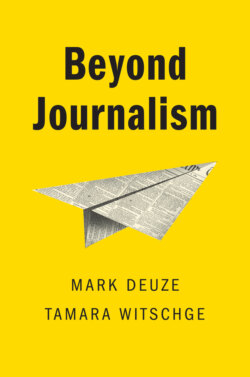Читать книгу Beyond Journalism - Mark Deuze - Страница 11
Structure of this book
ОглавлениеAs Montuori (2003: 543) notes about writing in the academic genre, it is “easier to leave all the personal, ambiguous, contextual material out. It is ultimately easier, I believe, to present just the context of justification, and leave out the messy context of discovery – or creation.” Indeed, both of us have found it a “tremendous creative challenge to be more transparent, to be more fully present” (ibid.) in this work, and though we both embrace this, what you will find here is only a partial answer to this challenge. We consider this book as a stepping-stone toward a more transparent, personal, and creative way of researching and writing about our field of study.
In the first part of the book, on the becoming of journalism, we critically interrogate the normative expectations of what journalism should be and do according to dominant conceptualizations of the profession. Newsrooms and newswork are part of a profession that can best be seen as a self-organizing social system through which shifting coalitions of participants are linked, and that is interdependent with a variety of other systems – such as sales, marketing, design, programming and coding, publishing and distribution services – in terms of its business models as well as its practices (consider, for example, emerging genres such as branded content, native advertising, automated journalism, and news aggregation). It is also a field with a distinct materiality of praxis (Sartre 1976: 79) – what journalism is and what journalists do cannot be meaningfully separated from their material context (such as physical workspaces, hardware and software, and technological affordances).
From this broad perspective, we outline how journalism is not nearly as consistent nor homogeneous as it is made out to be, and focus instead on providing stories of journalism that show the multiple, seemingly contradictory (self-) understandings, activities, values, and emotions that are part of the professional practice of journalism. In the subsequent chapters we operationalize this approach by focusing on those reporters, editors, and associated staffers who make up the countless startups, new media companies, editorial collectives, and other forms of small enterprises that are emerging all over the world. These are journalists who, as pioneer communities, give shape to the profession in all kinds of ways, deliberately and self-reflexively, a process that we document with a sense of wonder. How do they make it work, what does it take to strike out on your own like that, what does journalism mean to them, and what is the price they pay for their endeavors?
There is no neat summary and conclusion at the end of this book. We do not have a list of tips and tricks for how to be successful as a news startup and a journalism entrepreneur. We have opted to focus on particularity rather than imposing some kind of consistency or uniformity onto the data, onto our subjects. Throughout the book we have added short vignettes highlighting and profiling specific initiatives and people that we found inspiring or remarkable. These are people who made us think twice before labeling them in order to fit some preconceived notion of being a journalist or an entrepreneur. Ultimately, we hope the Beyond Journalism project, as initially outlined in this book, opens up fruitful ways of further exploration. Journalism is not on its way out, nor is it simply morphing into something else – it is being reimagined and creatively and passionately practiced in lots of different ways, and our work aspires to provide access to that process and these practices.
